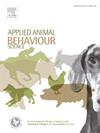母鸭(Cairina moschata x Anas platyrhynchos)对过度喂食的行为反应显示了在“鹅肝”生产阶段住房条件的影响
IF 2.2
2区 农林科学
Q1 AGRICULTURE, DAIRY & ANIMAL SCIENCE
引用次数: 0
摘要
“鹅肝”生产部门面临着各种挑战,其中过度喂养和住房条件是未来满足社会期望的主要决定因素。要在农场动物福利方面取得重大进展,需要经过科学验证的评估。迄今为止,确定过度喂养期间住房条件对骡鸭健康和福利的实际影响似乎很困难。科学文献仍然缺乏一种行为评估方法来监测“鹅肝”农场的过度喂养阶段。我们的研究旨在(1)开发和实施一种客观测量鸭在过量喂食期间行为反应的方法;(2)评估两种住房系统——高架集体围栏(ECP)和集体地板围栏(CFP)——对鸭在过量喂食前和喂食期间的福利的影响。开发的措施是基于两个具体指标表征鸭子的反应-挣扎和整体搅拌轮廓-对过度喂食和对喂食器。除了这些指标外,还收集了有关行为和健康的数据。试验在两个不同地点(以下简称“A点”和“B点”)的商业农场进行,并在两个地点重复进行两批试验。研究人员对1226只雄性骡子鸭(Cairina moschata x Anas platyrhynchos)进行了1.5 h的行为和健康数据记录,分别在过量喂食前和过量喂食期间进行了三次记录。ECP饲养的鸭子表现出更多的不适行为,而CFP饲养的鸭子在过量喂食前表现出更多的自然行为。饲养在ECP中的鸭子在过量喂食时也比饲养在CFP中的鸭子更激动和挣扎。此外,CFP饲养的鸭的大腿(两个试验点)和肝脏(A试验点)比ECP饲养的鸭重。在过量饲喂前和过量饲喂期间获得的结果是一致和互补的,为开发骡鸭反应性的新行为指标提供了强有力的支持。我们的研究结果还表明,在CFP中饲养的骡鸭在应对压力情况时表现出更有效的应对策略。这一策略得到了更多的机会来探索它们的环境,并在这个住房系统中参与特定物种的行为。最后,用CFP饲养的鸭子得到的结果与“一个福利”的概念一致,因为CFP不仅提高了鸭子的福利,也提高了农民的福利,鸭子的挣扎减少了,也不那么激动了。本文章由计算机程序翻译,如有差异,请以英文原文为准。
Mule ducks’ (Cairina moschata x Anas platyrhynchos) behavioural reactions to overfeeding show the impact of housing conditions during the ‘foie gras’ production stage
The ‘foie gras’ production sector faces various challenges, among which overfeeding and housing conditions are particularly determinant for the future to meet social expectations. Achieving significant advancements in farm animal welfare requires scientifically validated assessments. To date, determining the real impact of housing conditions during the overfeeding period on mule ducks’ health and welfare appears difficult. The scientific literature still lacks a behavioural assessment methodology to monitor the overfeeding phase in ‘foie gras’ farms. Our study aims to (1) develop and implement an objective measure of behavioural responses in ducks during overfeeding and (2) assess the impact of two housing systems – elevated collective pens (ECP) vs. collective floor pens (CFP) – on ducks’ welfare before and during the overfeeding meal. The developed measure is based on two specific indicators characterising ducks’ reactions – struggling and overall agitation profile – to overfeeding and toward the feeder. In addition to these indicators, data on behaviour and health were also collected. Trials were conducted on commercial farms at two separate sites (hereafter “site A” and “site B”) and repeated with two batches on both sites. Behavioural and health data were recorded for 1226 male mule ducks (Cairina moschata x Anas platyrhynchos) 1.5 h before overfeeding and then during overfeeding meals, three times throughout the overfeeding phase. Ducks housed in ECP showed more discomfort behaviours, while ducks housed in CFP expressed more natural behaviours before overfeeding meals. Ducks housed in ECP were also more agitated and struggled more during overfeeding than ducks housed in CFP. Moreover, the thighs (in both sites) and livers (in site A) of ducks housed in CFP were heavier than those of ducks housed in ECP. The results obtained before and during overfeeding meals align and complement each other, providing strong support for the development of new behavioural metrics for mule ducks’ reactivity. Our results also suggest that mule ducks housed in CFP exhibit a more effective coping strategy in response to stressful situations. This strategy is supported by the increased opportunity to explore their environment and engage in species-specific behaviours within this housing system. Finally, the results obtained with the ducks housed in CFP align with the 'one welfare' concept, as CFP enhances not only the well-being of the ducks but also the farmer’s well-being, with the ducks struggling less and being less agitated.
求助全文
通过发布文献求助,成功后即可免费获取论文全文。
去求助
来源期刊

Applied Animal Behaviour Science
农林科学-行为科学
CiteScore
4.40
自引率
21.70%
发文量
191
审稿时长
18.1 weeks
期刊介绍:
This journal publishes relevant information on the behaviour of domesticated and utilized animals.
Topics covered include:
-Behaviour of farm, zoo and laboratory animals in relation to animal management and welfare
-Behaviour of companion animals in relation to behavioural problems, for example, in relation to the training of dogs for different purposes, in relation to behavioural problems
-Studies of the behaviour of wild animals when these studies are relevant from an applied perspective, for example in relation to wildlife management, pest management or nature conservation
-Methodological studies within relevant fields
The principal subjects are farm, companion and laboratory animals, including, of course, poultry. The journal also deals with the following animal subjects:
-Those involved in any farming system, e.g. deer, rabbits and fur-bearing animals
-Those in ANY form of confinement, e.g. zoos, safari parks and other forms of display
-Feral animals, and any animal species which impinge on farming operations, e.g. as causes of loss or damage
-Species used for hunting, recreation etc. may also be considered as acceptable subjects in some instances
-Laboratory animals, if the material relates to their behavioural requirements
 求助内容:
求助内容: 应助结果提醒方式:
应助结果提醒方式:


